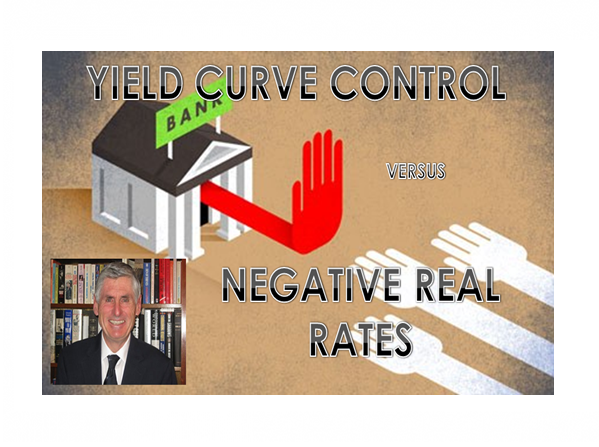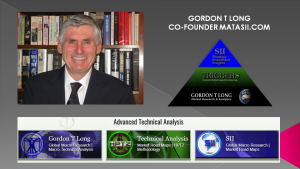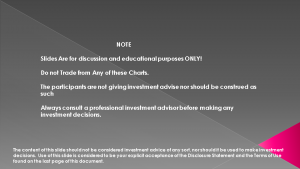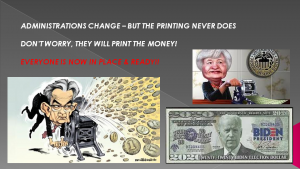IN-DEPTH: TRANSCRIPTION - LONGWave - MARCH - YIELD CURVE CONTROL versus NEGATIVE REAL RATES
SLIDE DECK
TRANSCRIPTION
COVER
Thank you for joining me. I'm Gord Long.
A REMINDER BEFORE WE BEGIN: DO NO NOT TRADE FROM ANY OF THESE SLIDES - they are COMMENTARY for educational and discussions purposes ONLY.
Always consult a professional financial advisor before making any investment decisions.
AGENDA
I am going to tackle a subject in this session that likely has little interest to most and will no doubt bore novice investors. However, I cannot stress strong enough how important it is that you understand it properly!
The subject is Treasury bond yields!
Why? Because the 800# gorilla IS the bond market not the stock market!
The stock market reacts to the bond & credit market. The stock market is simply the wagging tail on the dog!
If you want whiplash make your decisions from the tail. If you want to adequately anticipate what is ahead, and the risk you are taking you need to understand what is driving treasury yields, interest rates and credit ratings.
To this end we are going to discuss a few of the key important elements and what they are presently suggesting lies ahead!
To do this we will go cover the agenda shown here.
If you get to end of this session I can assure you will see it was worth the time! You will understand the investment opportunities that are going to be presented in the near term to those that see what is occurring.
So grab a hot cup of coffee and stay with me!
SLIDE 5
First we start with some apparent, well understood concepts!
- Real Rates and
- Fisher’s Equation
SLIDE 6
An individual who lends money for repayment at a later point in time obviously expects to be compensated for the time value of money for not having had the use of that money. That compensation comes in the form of nominal interest rates but for professional lenders more specifically in the form of Real Rates.
Nominal Rates include all the issues seen as part of #2 shown here. Real Rates only exclude number iv of #2 or inflation.
Do not forget Default Risk, Collateral Risk, Taxation & Regulatory Risk is all included in both. We are going to come back to that later.
SLIDE 7
We all understand that if the nominal rate is 5% to borrow and the inflation rate is 2% , then the lender would expect to make 3% and we would know as the borrower the cost was not really what it was advertised to be. It is actually cheaper for us as a borrower and is only 3%.
What’s complicated about that?
SLIDE 8
Well the famous Fisher’s Equation points out that this simple relationship may be a little more subtle than you might expect.
It states that the Nominal Interest Rate equals the Expected Inflation Rate plus the Real Interest Rate.
The first question is how is the inflation rate determined and where is to be found?
The answers are important because:
BORROWERS may be willing to BORRROW at Negative Nominal and Negative Real Rates!
But LENDERS are not going to LEND at NEGATIVE REAL RATES
- Unless they see Major Deflation Coming, or
- Unless they expect the Currency to Appreciate
SLIDE 9
Before we get to how inflation determined let’s consider some other points regarding the Fisher Equation.
Few appreciate, particularly in today’s environment, that it implies that when expected inflation changes, the nominal interest rate will increase. However, inflation will not affect the real interest rate. They are independent.
SLIDE 10
Think of it this way.
INFLATION is a measure of domestic inflation which moves the nominal rate. The Inflation Rate of the country does not necessarily move the real rate
REAL RATES: Are impacted by a shift in:
The relative value of the currency,
Global inflation pressures and
Credit worthiness.
There are further mis-understandings in the simple formula.
INTRINSIC VALUE: Falling Real Rates reflect a reduced intrinsic value of a Bond. Fisher's Equation says this will result in a reduced Nominal Rate as the interest revenue stream is perceived to be of less value.
MONETIZATION: Rising domestic inflation, due to the monetization of debt, will inevitably impact the domestic currency which then reduces the real rate, making nominal rates and their interest revenue stream worth less.
We will come back to all these points when we discuss how inflation rates and real rates are determined.
SLIDE 11
I show this chart as a way to begin to put some of this into context.
Money is created by the Central Banks. It is increasingly driven by Government borrowing.
When the government historically borrowed, at let’s say 6% with inflation of 2%, both the government and Bond Buyers, or lenders realized the contract was about a real rate of 4%.
From this, lenders such as the money center banks and lending banks had to subtract their lending costs to get a profit.
However, over the years the global carry trade has become a dominate force in lending, where it borrows in one country and lends in another.
If we use 2% to cover their costs and hedging facilities we see that it is a very tight squeeze to keep money flowing at even 6% nominal rates.
It’s been a long time since we have seen 6% bonds!
SLIDE 12
Since the Dotcom bubble implosion in 2000 until the 2008 financial crisis, rates were closer to 3% with relatively low perceived inflation.
This forced massive changes in global Basel Accord lending standards to keep world lending and credit flowing.
Deposit Ratios changed, capital adequacy ratios changed and even the value of sovereign treasuries concerning VaR calculations changed.
All this occurred before we were forced into the world of Quantitative Easing and Zero Bound rates!
SLIDE 13
Most recently with the advent of Quantitative Easing 1, 2 ,3 and Operations Twist we have experienced new issues with extremely low, sustained interest rates. And this was with inflation again perceived to be a non-factor and only a problem, which the central bankers never stopped talking about, since it couldn’t get it to rise – as thought this was somehow good for all of us?
But we will put that narrative aside for this discussion.
The problem was how to get keep lending occurring with low rates. Or how do lenders make money and stay incented to lending to ever more indebted borrowers??
SLIDE 14
The answer has been acceleration in highly leveraged short term lending.
We have witnessed a complete re-alignment of lending over the last 30 years.
Lenders used to BORROW LONG (Cheap) to LEND SHORTER (Expensive)
We have shifted now to BORROWING SHORT (Cheap), to LEND LONG (Expensive)
To borrow short lenders use Money Market Lending, Commercial Paper Lending, ABS, MBS and other vehicles. This has also forced us to further:
- Change Lending Deposit Ratios for example on short term Money Market Funds on Deposit with your bank,
- Basel Accord Capital Adequacy Ratios
- Treasuries as “Risk Free” Collateral = for ‘Unlimited’ lending facilities.
A shift has occurred to the domination of the Repo market for lending because of their use as regulatory collateral and application of all sorts of witch’s brews involving collateral transformations, novation, rehypothecation and many others highly questionable practice I have outlined in previous videos.
SLIDE 15
At lot of these came to light during the 2012 European banking crisis in Greece and Cyprus but have only gotten worse since; with the most recent being VIX shorting that resulted in a near collapse in the fall of 2018 with the Mnuchin Massacre in what was referred to as the VIXmaggodon.
SLIDE 16
We have leverage built on leverage with underpinning collateral almost non-existent, all in an attempt to lend and borrow at rates that simply don’t even come close to the risk being taken.
It is a recipe for disaster but if you are a lender this is the game you are trapped in to survive.
So what does this mean if rates are forced to go negative to keep this charade going?
SLIDE 17
What happens if the VIX rises and implodes the massive short term funding game using the shorting of the VIX to finance lending? Anything could set this off and seize-up the short term funding markets.
SLIDE 18
This is a shock we must be aware and consider when we talk about Negative Real Rates and the possibility of Yield Curve Control.
SLIDE 19
We are on the precipice of something close, as for the first time in decades the markets are experiencing the realities of Inflation and are reacting badly to it.
Two weeks ago, the short term 5Y Treasury Note Yield went parabolic and punched through its Convexity level. Something few have ever seen before.
SLIDE 20
The long end of the US Treasury curve for the 10 & 30Y bonds has moved higher in yields at a rate seldom ever seen before in the bond market.
Last Friday the 30Y German Bund moved over 25% in one day – something that has never occurred in history.
The funding markets are experiencing shocks that are sending warnings that things are “a kilter” in “Bond Land”!
SLIDE 21
.. and they are likely to get worse as more supply hits the market.
On the surface an avalanche of new liquidity will lift equity markets dramatically.
But who is going to fund it? How can over-leveraged, over-valued equity markets keep rising if lending rates also spike??
SLIDE 22
Now that we have a better perspective, let’s get back to the question we started with.
What will Negative Real Rates mean?
Are they even a possibility?
Why would Yield Curve Control be needed?
SLIDE 23
Well we know Negative Yields are possible since we have approximately $17 Trillion of them reported as already in existence in all the developed countries.
SLIDE 24
But we need to appreciate that Real interest rates can be negative, but nominal interest rates cannot. The last chart was in fact dominantly real rates, not nominal rates
Nominal interest rates generally cannot be negative because if banks charged a negative nominal interest rate, they would be paying you to borrow money!
This is called the Zero Bound.
SLIDE 25
A negative interest rate environment occurs when the nominal interest rate drops below zero percent for a specific economic zone. This effectively means that banks and other financial firms have to pay to keep their excess reserves stored at the central bank, rather than receiving positive interest income.
With negative interest rates, central banks charge commercial banks on reserves in an effort to incentivize them to spend rather than hoard cash positions.
With negative interest rates, commercial banks are charged interest to keep cash with a nation's central bank, rather than receiving interest.
If a central bank implements In theory, negative rates would boost the economy by encouraging consumers and banks to take more risk through borrowing and lending money.
Sweden, Switzerland, Japan and the 19 nations of the Eurozone all took interest rates below zero. In Switzerland, negative interest rates have also helped to discourage investors from pouring money into the country during times of uncertainty.
SLIDE 26
The Federal Reserve has never brought its benchmark rate into negative territory and, according to Fed Chairman Jerome Powell, the central bank is not considering going to negative interest rates now. Experts agree. What Powell is referring to is the Federal Funds Rate
Negative real rates since the end of WWII have become standard practice for reducing government debt levels when inflation doesn’t do it for them!
SLIDE 27
However, we are entering a new era when we have both negative real rates and rapidly rising inflation!
We additionally have massive expansion of the money supply along with public polices through a new US regime that is taking the country in a different direction as evidenced by recent executive orders (57 to be precise) that amongst other matters will make the US energy dependent again.
This is not to be political but the simply a statement of fact, of the degree to which the US economic direction is being presently transformed!
SLIDE 28
So how do we calculate inflation and real rates which so much of this discussion centers on?
SLIDE 29
The US uses the CPI as its measure of inflation to determine inflation and the real rate for its bonds?
If you have been following my work for any period of time you would know that statistical gimmicks such as substitution, hedonics and imputation make this absolute madness!
SLIDE 30
But this is how it is reported!
Shown here is the Inflation breakeven (which the Fisher’s Equation refers to as the inflation rate) and comes from the TIPS (the US Treasury inflation protected security).
It is shown here to have been reported this week as 2.22%. You can see it has been steadily rising since April of last year as the Coronavirus really took hold of the economy.
SLIDE 31
This is a longer term view going back to 2004. You will notice how extraordinary the recent rise in inflation has been.
You will also notice some trend lines which we will come back to when we discuss potential initial boundary conditions.
SLIDE 32
This is the US Real Rate used in the Fisher Equation. It also is derived from the US TIPS rate.
You can see it at -0.66% after approximating -1% since early summer.
SLIDE 33
Again we look at a longer term perspective. We see the current -0.66% real rate along with a long term trend line that approximates a positive 0.7% Real Rate.
The note at the bottom shows the arithmetic that then reflects the 10 US note approximating a nominal yield of 1.56% (before violently spiking on Friday to 1.64%).
SLIDE 34
When we place the elements of the 10Y US Treasury Note on a single graph it looks something like this.
SLIDE 35
If we lay in the boundary conditions we showed in red on the prior long term charts we get the potential for the 10 year Treasury note to close on a nominal rate of 1.85% before hitting some initial overhead resistance.
SLIDE 36
We found it interesting that this target is exactly what we have been showing on our 10Y chart which we have been sharing in our newsletters for quite some time now!
Coincidence maybe but then again, maybe not!
This chart shows 20, 40 and 80 Week moving averages all heading up or tuning up. The 20 WMA is about to cross the 80 WMA. These are unusually strong rises and beg the question of whether Fed policies can hold yields down? Then again, is that what they intend to do?
SLIDE 37
The Fed has so far consistently stated it doesn’t want to implement Yield Curve Control but has it available as a policy response.
SLIDE 38
Fed Funds are at zero, and the Fed has not committed to negative interest rates. What else can the Fed do to keep debt flowing?
The Fed sets short term rates but can only indirectly influence long-term rates. Longer-term rates spanning from two-year maturities out to thirty years drive borrowing and consumption.
Quantitative Easing (QE) was introduced in 2008 when the Fed Funds rate hit zero.
QE allows the Fed to purchase bonds in an effort to lower interest rates for longer-term maturities. During QE 1, 2, and 3, they bought Treasuries, mortgages, and agency bonds. Despite what one would think, on each occasion, longer-term rates rose. In the last month, they expanded their reach to include large-scale purchases of municipal bonds, corporate debt, and even junk-rated corporate bonds and ETFs.
Steering rates and setting rates are not the same. The question for the Fed is, how can they control interest rates for longer-term securities?
QE 1, 2, and 3 ran systematically. The Fed set a predetermined amount and timing of QE in which to operate. It was useful in reducing the supply of Treasuries available and forcing investors into riskier assets like junk bonds and stocks.
However, it did not allow the Fed to explicitly control the level of interest rates.
SLIDE 39
The Fed is now considering an enhancement to the way it manages QE. The “upgrade” is called yield curve control (YCC). YCC essentially allows the Fed to do unlimited amounts of QE with no time restraints.
Embedded in YCC is the specific goal of targeting particular interest rates across the entire yield curve.
For example, assume the Fed set a 0.75% target yield on the 10-year U.S. Treasury note. They can then employ QE in any amount needed to buy 10-year notes when the rate exceeds that level. If successful, the rate would never exceed 0.75% as traders would learn not to fight the Fed.
It is essential to be clear about the definition of YCC. The Fed represents it as an option for helping them manage the economy through the difficulties the country currently faces. However, YCC is a euphemism for price controls.
Price controls are government interference and regulation, establishing prices for specified goods and services.
SLIDE 40
It is called yield curve control because the central bank effectively manages the shape of the yield curve.
A steeper yield curve benefits the banks as they tend to borrow short term and lend long term. Larger profit margins increase their desire to lend and therefore stimulate debt-driven economic activity. Conversely, a flatter or inverted yield curve inhibits lending due to narrower bank profit margins, and consequently, it curtails debt issuance and economic activity.
The problem for the Fed is how they can steepen the yield curve to stimulate lending without letting longer-term rates rise too much? Under YCC, they may squirm out of one trap only to find themselves in a bigger trap.
SLIDE 41
The Fed would not break new ground with YCC. In fact, they would be reinitiating a previously used tactic. From 1942 to 1950, the Fed targeted rates to help manage funding costs for WWII.
It is worth pointing out that after WWII ended, inflation spiked to double digits, yet the Fed held interest rates at artificially low levels. While bondholders may not have lost money on the bonds per se, they did lose dearly in their purchasing power, as shown here
More recently, in 2016, Japan set a 0% yield target on its ten-year note. Currently, the bank of Australia is now targeting 0.25% for its three-year bond.
SLIDE 42
Federal Reserve Bank of New York President John Williams says that policymakers are “thinking very hard” about targeting specific yields on Treasury securities. Given what we have observed, it seems likely they will implement YCC and, in doing so, choose to keep digging and try to push problems out further into the future.
The problem with these actions is they engender anemic rates of economic growth. Equally concerning, they directly contribute to income inequality, a driving force for social unrest.
The policies the Fed staunchly defends are adverse to the healthy economic and social environment the country so desperately needs. While in crisis mode, investors will cheer them on unaware of the adverse effects it will have on the economy. As they say, there is no such thing as a free lunch.
SLIDE 43
So what does all this mean? What is it telling us?
SLIDE 44
We think real rates could rise towards a positive 0.70%. This is because the use of TIPS is flawed.
We are not including those factors that we mentioned to remember in our first slide – pricing in Risk in the form of Defaults, collateral value depreciation and regulatory changes.
We think these could be profound if we face our expected Deflationary Tsunami.
We think there is a change that the Fed will not be able to control yields and we could face 3.55% in 10y yields.
SLIDE 45
Sound absurd? Then consider if we don’t see that we could see major dollar weakness!!
We think the US dollar as measured by the DXY could approach 80 from a current level of 91.6 or an ~ 12.5 % drop.
We do see a short term lift in the US$ as the equity markets weaken between now and August and “flight to safety” to occur.
SLIDE 46
We are watching strange movements between the value of the Chinese Currency, the US dollar and Gold since the US election.
Gold was falling while the dollar weakened. This is the opposite of what normally happens. Meanwhile the Yuan has been quite strong.
We need to remember that Gold has been tracking the real rate of the US 10Y note and the 10Y note has been tracking the Chinese Credit Impulse. We laid this out in our last two newsletters (https://conta.cc/3cuttgK , https://conta.cc/38CL1WV )
SLIDE 47
We think there is a real possibility that the Fed along with other central bankers will as part of Bernanke’s “Enrich-thy-Neighbor’ policy will use a slowing rate of the global liquidity proxy to trigger an effective “TAPER” program.
We are seeing early signs of a slowing rate of the liquidity proxy!
What mainstream economists call a “rate tantrum” is when rates go up, markets down as investors unwind risk-on bets is in reality a “rate hangover” or simply waking up from a binge-drinking fest, of disproportionately low rates for too long. The worst is that rates are so abnormally low anyway and risky bets so high that even a set of dovish messages from central banks cannot prevent a correction.
Ned Davis Research estimates that a 2% yield in the US 10-year bond could lead the Nasdaq to fall 20%, and with it the entire stock market globally.
SLIDE 48
The Chinese Credit impulse (which leads the UST 10Y Yield rate by 12 months has a lot further to rise and take real rates with it.
SLIDE 49
A move here from 26 to 32 is approximately a 23% increase. This would be a move from a 10Y real rate from -0.66 to -0.51
SLIDE 50
This has the potential to take gold down to 1450/oz in current US dollars. This may not be as severe if the SU dollar rises in the near term to 94 as we showed on the previous US$ DXY chart.
SLIDE 51
There is a strong possibility that the Fed will:
- Let the Long End of the Curve rise using an effective “TAPER” to control rates somewhat,
- This will negative impact the over-leverage equity markets,
- A “Flight to Safety” will initially take the dollar higher through August
- As the economy’s focus shifts from Inflation to Deflation the Fed will launch YCC,
- YCC will take the US% lower assisting the Fed.
- The Fed will sacrifice the US$ to be able to stabilize lending and government debt requirements.
As closing comment, there is no problem in a 2% US 10-year bond yield in normal conditions of a growing economy with 2% inflation. There are a lot of problems when entire markets have based their valuations on inflationary policies not generating inflation.
The risk of a financial crisis does not come from rising bond yields.
The risk of a financial crisis was created by lowering bond yields to unrealistic and unjustifiable levels in the first place. Any crisis will have been of the Fed’s own making!
SLIDE 52
As I always remind you in these videos, remember politicians and Central Banks will print the money to solve any and all problems, until such time as no one will take the money or it is of no value.
That day is still in the future so take advantage of the opportunities as they currently exist.
Investing is always easier when you know with relative certainty how the powers to be will react. Your chances of success go up dramatically.
The powers to be are now effectively trapped by policies of fiat currencies, unsound money, political polarization and global policy paralysis.
SLIDE 53
I would like take a moment as a reminder
DO NO NOT TRADE FROM ANY OF THESE SLIDES - they are for educational and discussions purposes ONLY.
As negative as these comments often are, there has seldom been a better time for investing. However, it requires careful analysis and not following what have traditionally been the true and tried approaches.
Do your reading and make sure you have a knowledgeable and well informed financial advisor.
So until we talk again, may 2021 turn out to be an outstanding investment year for you and your family.
Thank you for listening






